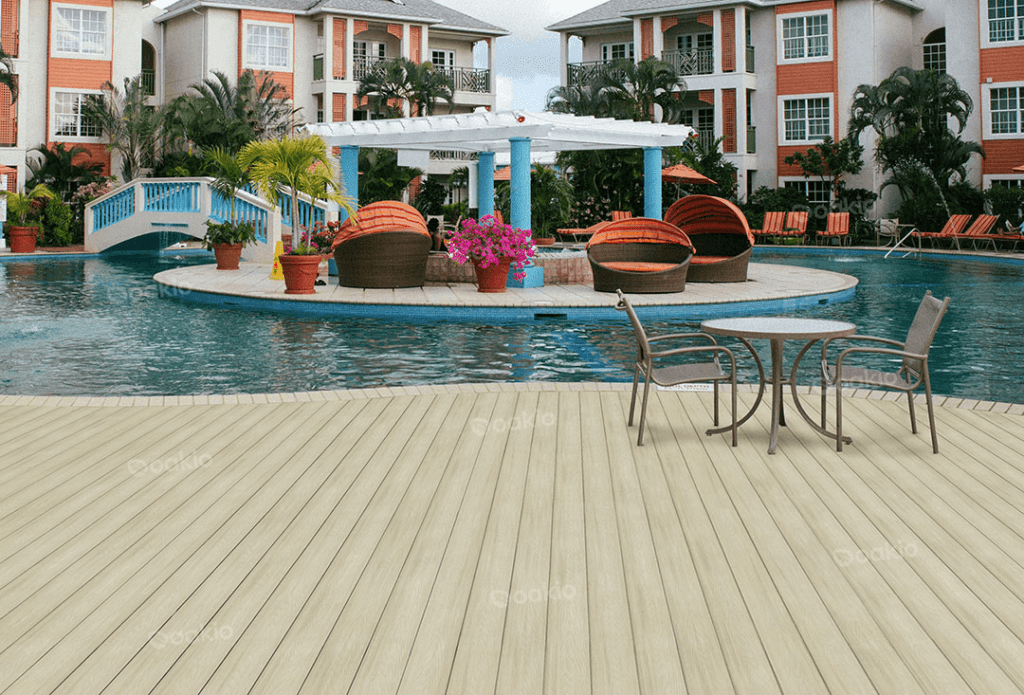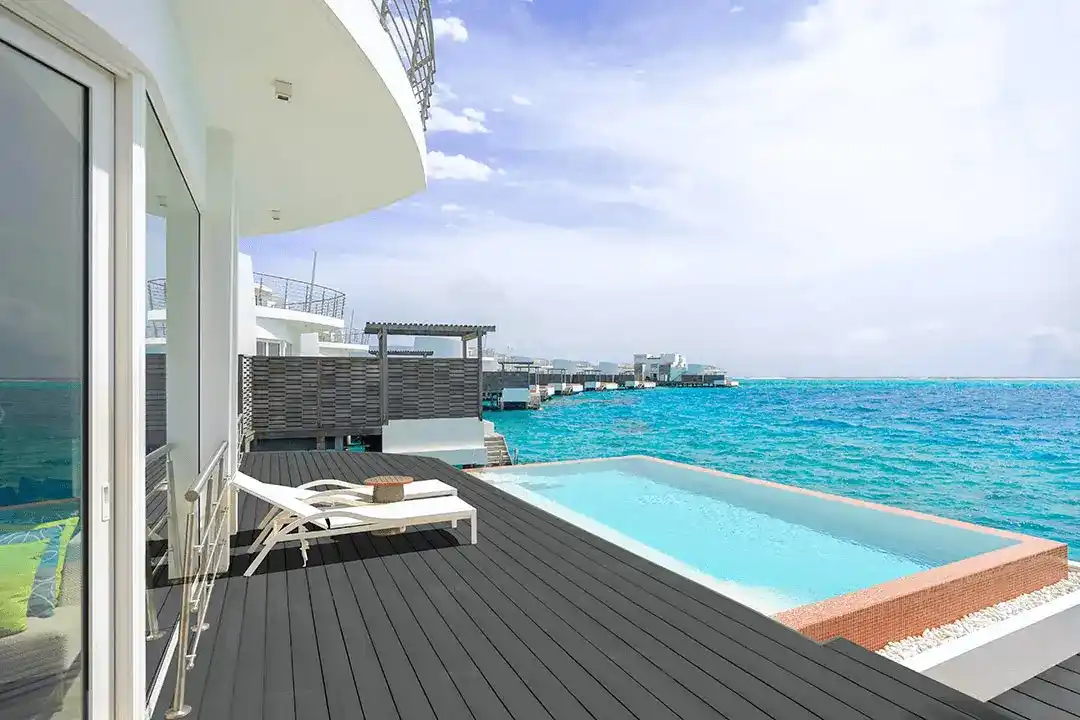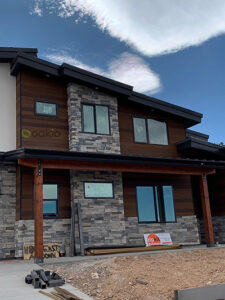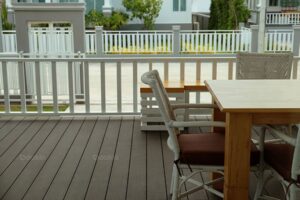Ultimate Guide to Deck Waterproofing: Protect Your Deck from Moisture Damage
Wondering why deck waterproofing is so crucial? Water damage can be a silent destroyer, creeping in and causing rot, mold, and mildew. This can lead to costly repairs and even structural damage. Waterproofing your deck extends its lifespan and keeps it looking great, ensuring it remains a safe and enjoyable space for you and your family.
Regularly resealing the wood and installing flashing tape are like magic shields, repelling water and keeping your deck healthy for years to come. Alternatively, consider composite or PVC decking. These champions boast a blend of inorganic materials, naturally resisting water’s destructive ways and eliminating the need for constant resealing. While achieving complete water invincibility for your wood deck might be a fantasy, there are ways to extend its reign as your outdoor oasis!
Choosing the Right Waterproofing Method
Choosing the right waterproofing method for your deck can feel overwhelming, but it doesn’t have to be. Here are some popular options:
- Sealants: Sealants are a go-to for many homeowners. They penetrate the wood and provide a barrier against moisture. They’re easy to apply and are great for preserving the natural look of your wood deck.
- Membranes: These are sheets of waterproof material that you can lay over your deck surface. They’re highly effective and offer excellent protection, especially for flat or low-slope decks.
- Under-Deck Systems: These systems capture water that seeps through the deck surface and channels it away, keeping the area beneath your deck dry and usable.
- Waterproof Deck Coatings: You apply these liquid products to your deck surface. They form a tough, protective layer that repels water and withstands foot traffic.
Each method has pros and cons, so consider your deck’s needs, budget, and willingness to do maintenance when choosing the best option.
Step-by-Step Guide to Waterproofing Your Deck

Step 1: Clean Your Deck Thoroughly
Before you start the waterproofing process, you need to clean your deck. Remove any furniture, plants, and debris. Use a deck cleaner to remove paint, grime, and mildew. A pressure washer can be helpful, but be careful not to damage the wood.
Step 2: Make Necessary Repairs
Inspect your deck for any signs of damage. Replace any rotten or damaged boards, and hammer in any loose nails. Sand down any rough spots to ensure a smooth surface for the waterproofing products.
Step 3: Choose Your Waterproofing Product
As mentioned earlier, you have several options. Pick the one that best suits your needs. Sealants are great for maintaining a natural look, while membranes and coatings offer robust protection. Make sure to follow the manufacturer’s instructions for the best results.
Step 4: Apply the Waterproofing Product
Use a brush or roller to apply an even layer of the product to your deck for sealants and coatings. Make sure to cover all surfaces, including railings and steps. If you’re using a membrane, carefully lay it out according to the instructions, ensuring there are no gaps or bubbles.
Step 5: Let It Dry
Allow the waterproofing product to dry completely. Depending on the product and weather conditions, this can take anywhere from a few hours to a couple of days. To ensure the best results, avoid using your deck during this time.
Step 6: Regular Maintenance
Perform regular maintenance to keep your deck in top shape. Clean it periodically and reapply the waterproofing product as needed. This will ensure your deck remains protected and looks great for years.
Common Waterproofing Mistakes to Avoid
Avoiding common waterproofing mistakes can save you time and money. Here are a few to watch out for:
- Skipping the Cleaning Step: Applying waterproofing products on a dirty deck can prevent them from adhering correctly, leading to ineffective protection.
- Ignoring Repairs: Waterproofing over damaged wood won’t fix the underlying issues. Always repair your deck before applying waterproofing products.
- Using the Wrong Product: Make sure you choose a waterproofing product that’s suitable for your deck material and climate.
- Not Allowing Enough Drying Time: Be patient and let the product dry completely. Using your deck too soon can compromise the waterproofing process.
Benefits of a Waterproofed Deck
Waterproofing your deck offers numerous benefits:
- Extended Lifespan: Protecting your deck from moisture extends its life, saving you money on repairs and replacements.
- Enhanced Appearance: Waterproofing products help maintain the natural beauty of your deck, keeping it looking new for longer.
- Increased Safety: A well-maintained deck is a safe deck. Waterproofing prevents rot and structural damage, ensuring your deck is safe to use.
- Better Usability: Waterproofing can keep the area under your deck dry, creating additional usable space for storage or entertainment.
Expert Tips for Deck Waterproofing
Here are some expert tips to help you get the most out of your deck waterproofing efforts:
- Test the Water Absorption: Sprinkle water on your deck. If it beads up, your deck is still protected. If it soaks in, it’s time to reapply your waterproofing product.
- Use High-Quality Products: Invest in high-quality waterproofing products. They may cost more upfront but offer better protection and last longer.
- Consider Professional Help: If unsure about the waterproofing process, hire a professional. They have the experience and tools to ensure your deck is adequately protected.
Waterproofing your deck is a crucial step in maintaining its beauty and functionality. By choosing the right waterproofing method, following a thorough application process, and performing regular maintenance, you can enjoy a stunning, durable deck for years to come. Remember, a little effort now can save you time and money.
Trending Reading
What Are the Differences Between the WPC Board and PVC Board?
[2024 Update] How Long Does WPC Decking Last?













